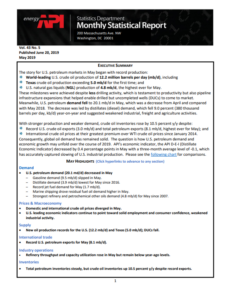The American Petroleum Institute released its latest Monthly Statistical Report and API Industry Outlook outlining the increased growth and resiliency of the US natural gas and oil industry. Namely, US crude oil production reached a new all-time high of 12.2 million barrels per day (mb/d) in May 2019.
This increase was driven by a combination of productivity gains and new pipeline capacity that allowed drilled but uncompleted wells (DUCs) to start supplying product to the market.
More specifically, highlights from the May 2019 Monthly Statistical Report include the following:
- US crude oil production of 12.2 million barrels per day (mb/d);
- Texas crude oil production exceeded 5.0 mb/d for the first time;
- US natural gas liquids production of 4.8 mb/d, the highest ever for the month of May;
- Record US petroleum exports at 8.1 mb/d, the highest ever for the month of May;
- US crude oil inventories increased by 10.5 percent over May 2018 levels despite the record exports.
[smlsubform prepend=”GET THE SAFETY4SEA IN YOUR INBOX!” showname=false emailtxt=”” emailholder=”Enter your email address” showsubmit=true submittxt=”Submit” jsthanks=false thankyou=”Thank you for subscribing to our mailing list”]
Regarding the API Industry Outlook for the second quarter of 2019, it reports that oil markets appeared balanced in spite of an expected slowdown in the global economic outlook. What is more, solid productivity has underpinned continued natural gas and oil production growth, making the production more stable over the last three years as shale production has grown.
In addition, the Permian basin and Bakken formation are expected to experience continuous growth with the expansion of pipeline takeaway capacity, which heightens urgency to expand US crude export capacity.
On the other hand, global LNG prices fell to record lows led by LNG capacity additions in the US and Australia, which should stimulate global LNG demand.
What is more, decreased ethane feedstock prices have supported competitiveness of US petrochemical production that advances the energy revolution.
API Chief Economist Dean Foreman commented on the report:
If current predictions by the U.S. Energy Information Administration and others prove correct, the U.S. will likely push up against the lower bound of existing crude oil export capacity by the end of this year, which creates urgency around building new infrastructure to ensure we don’t miss out on this rare opportunity
See more details in the PDF herebelow






























































